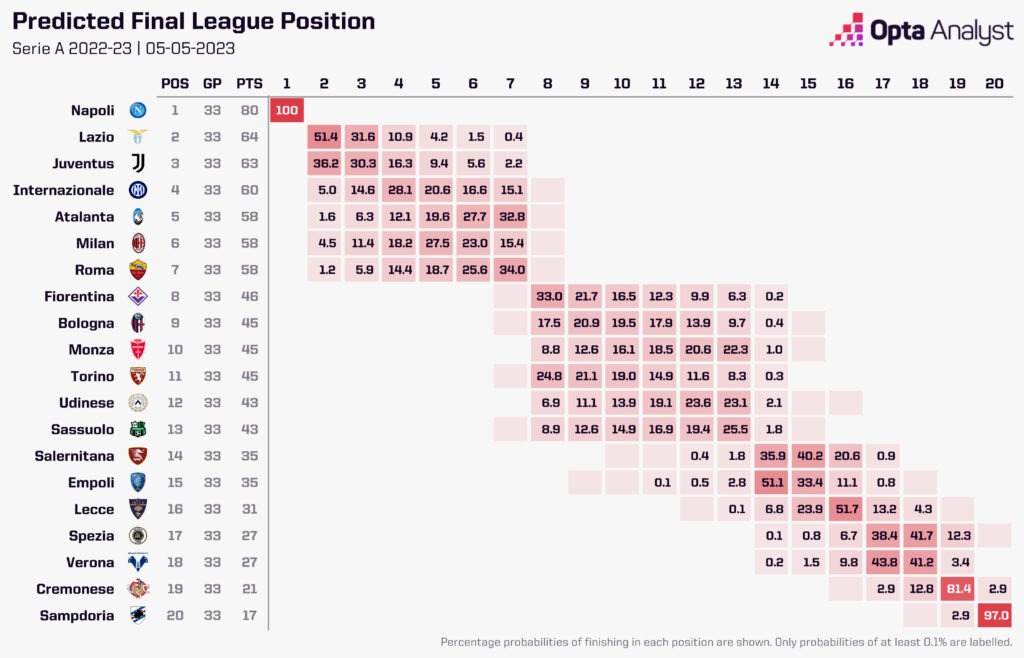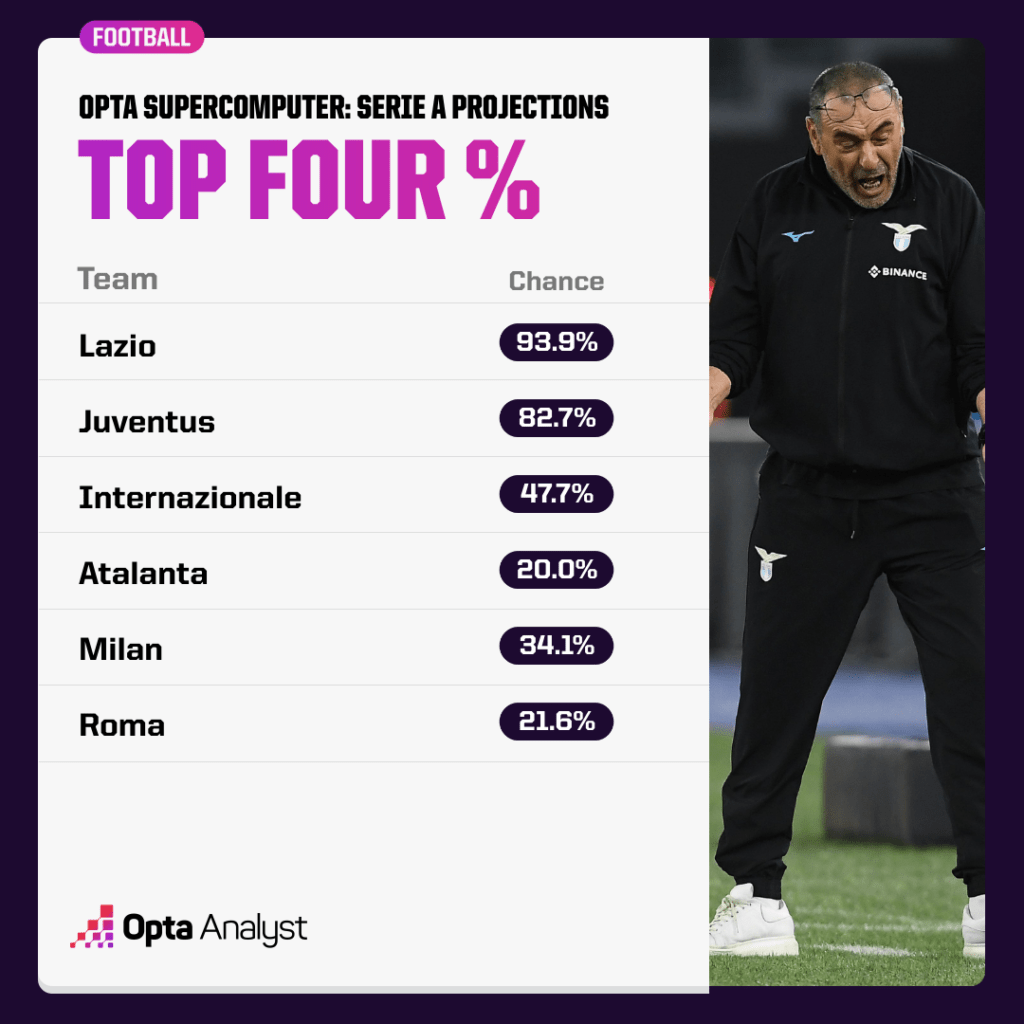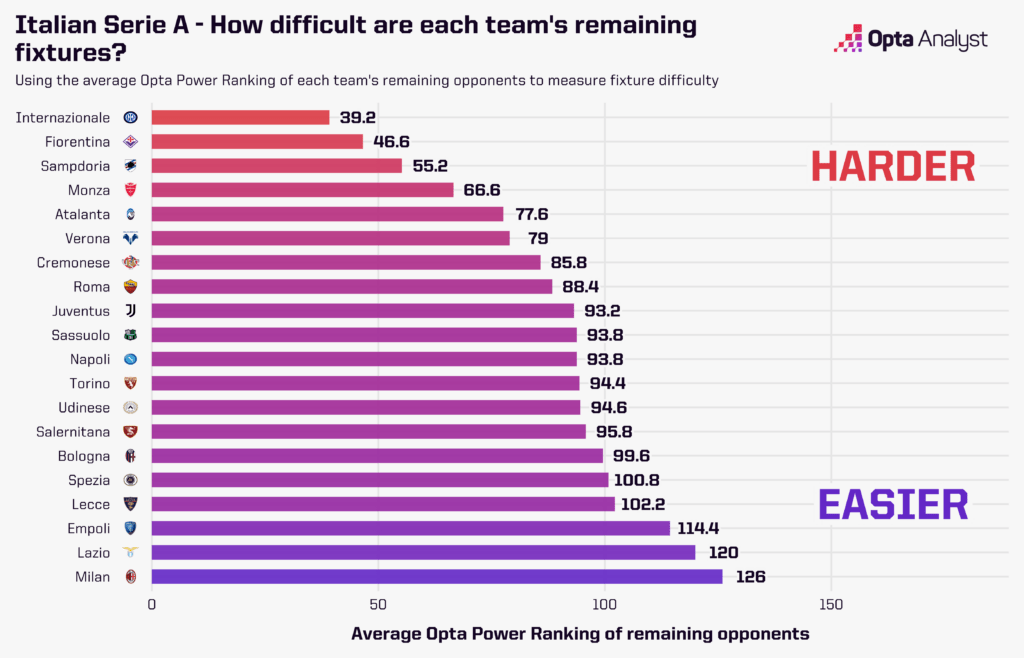Napoli have sewn up the Serie A title, but the battle for the remaining three Champions League spots is excitingly close. We look at the Opta supercomputer’s latest Serie A predictions.
It has been a fascinating season in Italy, with a romantic story around Napoli running away with their first Scudetto in 33 years, Juventus being slapped with a points deduction, and then un-slapped, while Milan and Inter try to balance outstanding Champions League campaigns with Jekyll and Hyde performances in the league.
As part of the tight battle for the top four, you also have Jose Mourinho being Jose Mourinho as he tries to get Roma back into the Champions League, while Maurizio Sarri finds himself sandwiched between two former employers as Lazio became the unlikely closest challenger to Napoli, though it would be very generous to say it was in any way close.
At the other end of the table, things look bleak for Sampdoria and Cremonese, with four other teams still in danger of relegation according to the Opta supercomputer.
We have fired up that very machine to try and make sense of the Serie A table with just a handful of games to go to try and predict where everyone will finish when the music stops.

Who Will Qualify for the Champions League?
Napoli’s draw at Udinese on Thursday night finally sealed a first Serie A title for Gli Azzurri since 1990 after weeks of failing to confirm their status as Italy’s current best side. That’s the title-winners and the first spot for UEFA Champions League qualification sorted.
The rest of the top four is an entirely different story though, with six teams fiercely contesting the remaining three places. Lazio sit in second spot with Sarri having done an impressive job with the Biancocelesti, and the supercomputer gives them a 93.9% chance of qualifying for the Champions League for the first time since 2020-21, and a 51.4% chance of doing so by finishing second, which would be their highest finish since they won the league in 1999-00 under Sven-Göran Eriksson. Lazio also have the second-easiest run-in according to the average Opta Power Ranking of each opponent (120).

Juventus’ hopes are much healthier since their 15-point deduction for alleged transfer finance discrepancies was overturned, with Wednesday’s win over Lecce increasing their likelihood of a top-four finish to 82.7%, with a 36.2% chance of pipping Lazio to second, and 30.3% likelihood of ending where they currently sit in third.
Inter looked to be struggling after a shock 1-0 home defeat to Monza last month, but wins over Empoli, Lazio and a midweek 6-0 rout of Hellas Verona have catapulted them back into the top four, with the supercomputer believing Simone Inzaghi’s men could well secure another Champions League campaign, giving the Nerazzurri a 47.7% chance, and making them favourites at 28.1% to finish in fourth place.
That percentage would likely be higher if it wasn’t for Inter’s tricky looking run-in, estimated to be the hardest in the entire league based on the Opta Power Rankings, with Roma and Napoli away and Atalanta at home among their remaining five games, meaning they face an average opponent Power Ranking of 39.2.
Similarly, three wins on the bounce have seen Atalanta force their way into the conversation, but despite moving up to fifth place after Wednesday’s 3-2 win against Spezia, they are given just a 20.0% chance of a top-four finish, with Milan afforded a 34.1% chance despite sitting behind Gian Piero Gasperini’s men on goal difference.
The Rossoneri are fancied more than seventh-placed Roma as well (21.6%), who also sit on 58 points with Atalanta and Milan, behind the latter only on goals scored. That is because Milan have the easiest estimated run-in in the league, facing three of the bottom four in their remaining five games (Spezia, Sampdoria and Hellas Verona), with an average opponent Power Ranking of 126. However, Stefano Pioli’s side have drawn three of their last four home games in Serie A, as many as in their previous 19 outings.
Atalanta host Juventus next, while they also travel to face Inter in their penultimate game. Roma face Inter next at the Stadio Olimpico in what could be a pivotal game for both sides, with the Giallorossi needing to arrest a drop in form that has seen them fail to win their last three (D2 L1). Mourinho surely needs to get something against his former club on Saturday to keep their chance percentage for Champions League qualification in double figures.

Who Will be Relegated from Serie A?
Things look bleak for Sampdoria, which will bring a tear to the eye of those who delighted in watching the likes of Attilio Lombardo, Roberto Mancini and Gianluca Vialli taking Samp to the 1992 Champions League final. They are 10 points from safety with five games remaining, and also have the third most difficult run-in, with their three away games including Milan and Napoli, meaning an average opponent Power Ranking of 55.2. All this leads to Opta’s supercomputer giving them less than a 0.1% chance of survival.
Cremonese look almost certain to join them, despite an impressive 1-1 draw at San Siro against Milan on Wednesday, now six points from safety and given just a 2.9% chance of staying up. Hellas Verona and Spezia are level on 27 points, with the latter considered likelier to fill the final relegation spot (54.0% to 44.6%). Four points ahead of them, Lecce look to be fine, with just a 4.3% chance of slipping into 18th place, while Empoli are almost certainly safe after their 3-1 win over Bologna on Thursday – their chances now at just 0.04%.
How Does the Supercomputer Model Work?
• Opta’s League Prediction model estimates the likelihood of teams finishing in each position in the competition. We can therefore see how successful a team’s season is likely to be, whether it’s their relegation or title chances.
• The model estimates the probability of each match outcome (win, draw or loss) by using betting market odds and Opta’s team rankings. The odds and rankings are based on historical and recent team performances.
• The model considers the strength of opponents by using these match outcome probabilities and simulates the remaining fixtures in the competition thousands of times. By analysing the outcome of each of these simulations, the model can see how often teams finished in each league position to create our final predictions.
Enjoy this? Subscribe to our mailing list to receive exclusive weekly content. And follow us on Twitter too.
